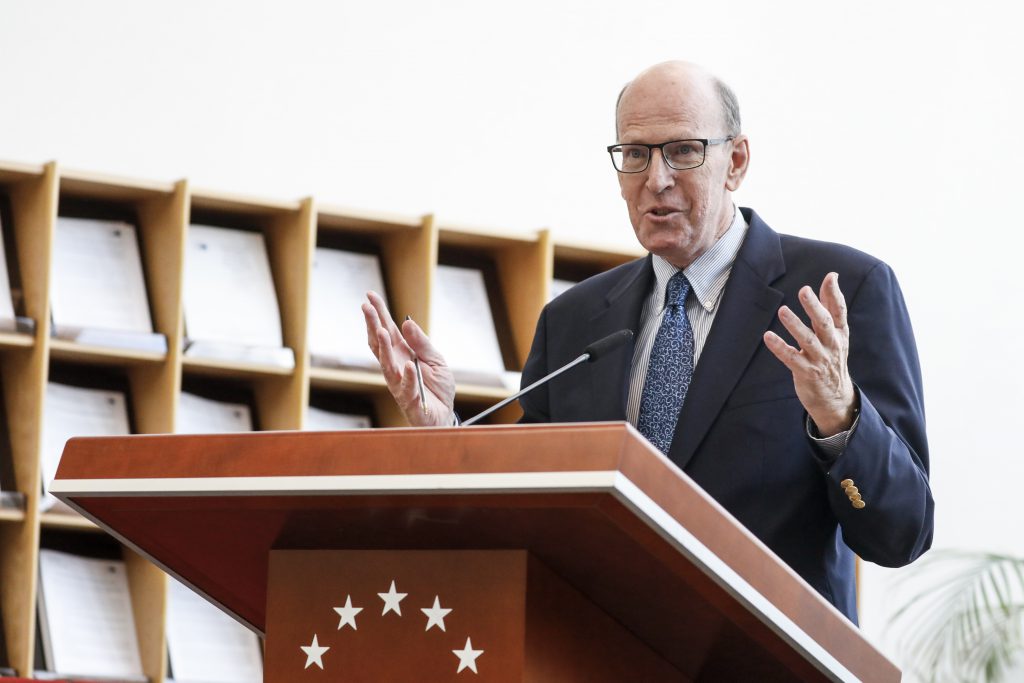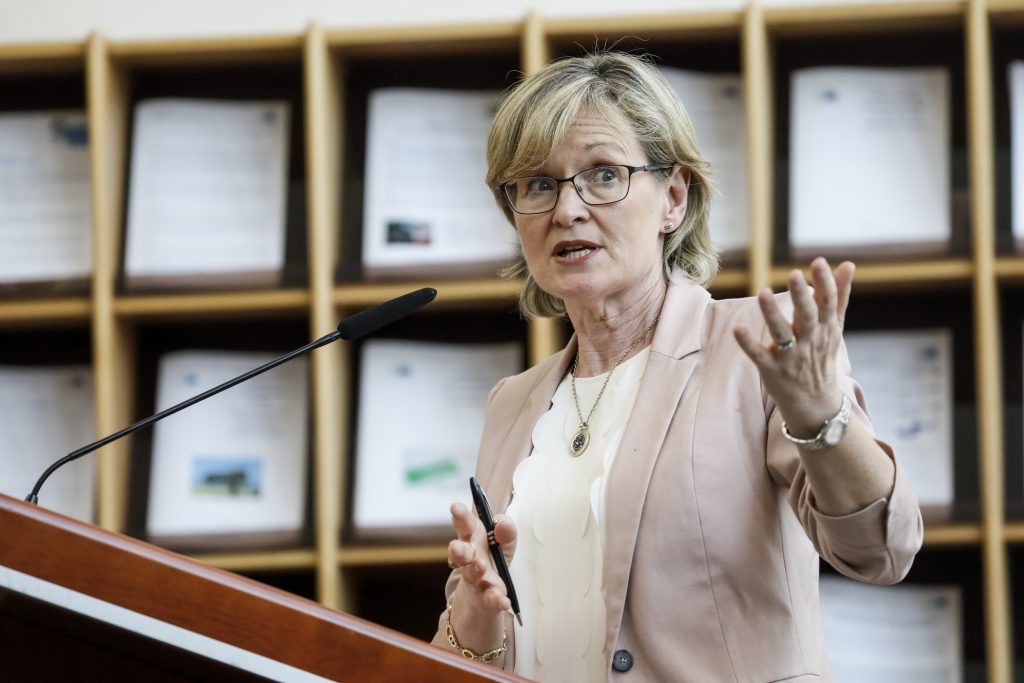Written by Desmond Dinan and Gaby Umbach,

The European Parliament (EP) has long been a magnet for academic inquiry, especially since the relance européenne of the late 1980s. While supranationalists and liberal-intergovernmentalists sparred over the reasons for the EU’s revival, a new generation of quantitative and comparative political scientists turned their attention to the conduct of legislative decision-making. They focused on the EP, seeing it as a distinctive but not necessarily unique entity, best understood by means of comparative analysis. The idea of the European Union (EU) as a complex polity, as a system of multi-level governance, grew out of this approach.
Nevertheless, a gap opened between what political scientists observed and what officials and politicians experienced. People working in the EP undoubtedly enjoyed this academic attention, although they could not always recognise themselves or their institution in the books and articles that resulted from it. The contrast between works by practitioners and academics is sometimes striking, with thick description and empirical evidence being increasingly at odds with theoretical frameworks and conceptual approaches.
The problem might not simply be the result of over-specialisation, methodological innovation, and rising barriers to academic advancement. It could also be due to excessive faith in comparativism. The EP is, indeed, a parliament, to which the tools of parliamentary studies can, and should, be applied. However, the EP is not like any other parliament. It is a supranational, directly elected body, the only one of its kind in the world. The challenges and idiosyncrasies that come with such a singular status risk being lost in highly quantitative, comparative analyses. The greatest loss may be the failure of many academic works on the EP to capture the colour, drama, and political theatre that infuse the institution.
The apparent similarity between the EP and national parliaments, which the work of comparative political science has strongly reinforced, is both a blessing and a curse. On the one hand, the seemingly close comparison between the EP and its national analogues helps to make the EP more familiar to European citizens, thereby strengthening the institution’s informal legitimacy. On the other hand, the evident uniqueness of the EP, which comparative studies often miss or simply pass over, undermines the same informal legitimacy.
The best approach to analyse the EP, perhaps, is to use comparative methods to the extent that they help students and scholars of the EU to understand better how the EP operates. At the same time, it behoves EU scholars to emphasise the uniqueness of the EU polity and institutional apparatus, including the EP. Otherwise, EU scholarship runs the risk of missing a vitally important point about the EP, which is, quite simply, that it is a parliament unlike any other.
Inaugural lecture
These reflections formed the backdrop against which Desmond Dinan, Professor of Public Policy at George Mason University, Virginia, USA, and the first European Parliamentary Research Service Visiting Fellow, inaugurated the new EPRS Annual Lecture series on 11 July 2018, at the EP’s Library Reading Room in Brussels. Welcomed by Anthony Teasdale, Director-General of EPRS, and introduced by Mairead McGuinness, First Vice-President of the European Parliament, Dinan presented his analysis of the development of academic research on the EP, highlighting main trends and elaborating on discernible gaps.
In his lecture, Dinan sought to draw a mental and intellectual map of EP studies. The EP, as an institution in the broadest sense, incorporating norms, values, behaviour and organisational features, forms the features on this map. Academics are the self-appointed mapmakers, who try to outline the contours of the terrain and discern the connections between different EP features. The terrain of EP studies is multi-dimensional, and requires a multi- and an inter-disciplinary approach.
In general, Dinan identified a certain critical gap between academics analysis and parliamentary practice that often did not seem to reflect the same reality. Moreover, the strong focus on quantitative research and addiction to data mining often resulted in blindness towards the impressive environment parliament offered, including its ‘soft’ features and ‘sense of theatre’ that characterised supranational parliamentary work and life. Contextualisation of results was hence often missing in quantitative approaches, making them partially myopic to the reality of EP politics.
Acknowledging that his EPRS fellowship had deepened his personal, academic, and institutional understanding of such EP characteristics, for the purpose of his lecture, Dinan adopted a temporal perspective as well as an historical institutionalist approach. He subdivided his review of historical, political science, sociological, and anthropological research on the EP into four broad periods: 1952-58, corresponding to the existence of the Common Assembly of the European Coal and Steel Community (ECSC); 1958-79, from the launch of the European Economic Community, and with it the European Parliamentary Assembly, to the first European Parliament elections; 1979-92; from the first elections to the Maastricht Treaty, as a result of which the EP acquired real legislative power; and the period since 1992.
The Common Assembly

From 1952 to 1958, the Common Assembly became subject to academic attention in view of growing interest in European integration. The dominant perspective of this phase in political sciences was International Relations (realism and liberal internationalism being especially relevant), while subsequent studies drew on diplomatic history. These two central disciplinary perspectives were later challenged by comparative politics in the case of the former and by political, social, and cultural history in the case of the latter, when research on the EU witnessed its ‘polity-building’ turn. Social and cultural institutionalism from the anthropological and political sociology perspective added to this.
Related to the early, academically often dismissed period of European integration, researchers were particularly interested in post-war global and regional institution building. The United Nations and the Council of Europe became special reference points of analysis in this phase. The early 1950s witnessed a shift of attention towards the assemblies of these new global and regional institutions, also putting the Common Assembly of the ECSC on an academic radar that was still more populated by studies on the consultative assembly of the Council of Europe, which contemporary academics expected to become the most relevant regional institution for Europe. Research on European integration at that time was partially influenced by German academic interest in federal institution-building, at a national level in the new Federal Republic and at the supranational level in Europe.
US – or US-based – academics were especially important, thanks to generous government funding, not least because of intense interest in geostrategic developments. Ernst B. Haas, a German-born, American academic, wrote his seminal work, The Uniting of Europe (1958), following a sabbatical year studying the High Authority in Luxembourg. In this book, Haas developed the theory of neo-functionalism to explain the emergence of the European Community and predict its development. This theory posited the idea of policy spillover, and suggested that European business and political elites would gradually shift their allegiance from the national to the European level of decision-making. For that reason, Haas was extremely interested in the role of the transnational families in the Common Assembly.
Other academics at the time were drawn to the Common Assembly not only because its members organised themselves into political groups, but also because of the Common Assembly’s right to hold the High Authority to account, and the eagerness of its members to extend the Assembly’s limited powers. Indeed, the behaviour and attitude of its members was different from any other assembly of the period as, from very early onwards, they pushed hard to maximise the political influence of their dual national and European mandates, aiming to extend the competences of the newly established supranational (parliamentary) level. Early scholars of European integration realised that the Common Assembly was far more interesting and politically important than the Consultative Assembly of the Council of Europe.
Subsequent historical analyses of the Common Authority bore out the assessments of the early scholars. The work of Sandro Guerrieri stands out, in particular his 2016 magnum opus, Un Parlamento oltre le nazioni. L’Assemblea comune della CECA e le sfide dell’integrazione europea (1952-1958). Two other, recent contributions by historians are also noteworthy: an article by Mechthild Roos (2017) on the EP’s gain in power, 1952- 1979, and a book by Jacob Krumrey (2018), on the symbolic politics of European integration, which includes two chapters on the Common Assembly.
The European Parliament: early years

This period of initial interest in the Common Assembly was followed by a second period of research, from 1958 to 1979, which was arguably the least satisfactory for the analysis of the EP. Not many new scholars turned their attention towards the Parliament. Developments in European integration itself added to the deceleration of academic enthusiasm for the EP, and debunked the dominant theory of neo-functionalism. Specifically, the Empty Chair crisis was not only a disruptive episode for the nascent European Community (EC), but also for scholarship on European integration. From this crisis emerged Stanley Hoffmann’s article (1966) on the resilience of the nation state, which inspired a realist-intergovernmentalist perspective on the trajectory of European integration during the problematic period of the 1970s.
The economic and political setbacks of the ‘long’ 1970s led some academics to suggest that the EC had entered the ‘dark ages.’ Recently, historians have pointed out that the Community was surprisingly vibrant at that time. There were important initiatives in fields such as global development, the environment, monetary policy, and foreign policy. There were also significant institutional developments, notably the treaty changes of 1970 and 1975 granting budgetary authority to the EP; the launch of the European Council in 1975; and the decision finally to hold direct elections to the EP, which took place in 1979. The prospect of direct elections elicited considerable academic interest, including a number of general texts on the EP. As many of these academic works pointed out, however, the EP was still far from being a ‘real’ or a ‘normal’ parliament, primarily because it still lacked legislative authority.
Analysts of the first direct elections asked a question which recurs to this day, after each round of EP elections: are these elections truly European or are they really separate sets of national elections? Karlheinz Reif and Hermann Schmitt answered the question in 1980 by claiming that the first direct elections were really nine second-order national elections (the EC then had nine Member States). Subsequent academic analyses, after each round of EP elections, has confirmed this conclusion. The first European elections in 1979 were nonetheless a huge event for the European Community as a whole, and a wake-up call for scholars analysing the EP, even if this led to occasional insomnia in EP studies between election phases, rather than to a sustained interest in the EP.
Acceleration of European integration
The fortunes of the EC, and with it the EP, changed profoundly during the next period under review, from 1979 to 1992. The year ‘1992’ became a catchphrase for the revival of European integration following implementation of the Single European Act (SEA) in 1987, and the launch of the single market programme at the end of the decade. The EP contributed to the relaunch of the EC with its famous Draft Treaty on European Union, which emerged from the work of Altiero Spinelli, the veteran Euro-federalist, who formed a cross-party group of MEPs to advocate treaty change. Academics at that time continued to write about direct elections (in 1984 and again in 1989), and about the emergence of the Draft Treaty and its possible impact on the inter-governmental negotiations that resulted in the SEA. Academics also appreciated that the SEA brought about a major increase in the EP’s legislative power. Though still unique, the EP was becoming more ‘normal’.
Academic interest in the EC picked up considerably in tandem with the acceleration of European integration. There was a return to ‘grand theory’, as academics sought to explain what was happening. The most striking of these contributions was an article by Andrew Moravcsik (1991), which argued that the SEA had come about because of a convergence of domestic policy preferences for market liberalisation and integration among the EC’s three leading Member States (France, Germany, and the United Kingdom). This was the basis of Moravcsik’s theory of liberal intergovernmentalism, which he developed in his book (1998), The Choice for Europe. With the revival of grand theory, came a revival of supranationalism as a means of understanding the events of the late 1980s. After all, the activism of Commission President Jacques Delors and the momentum that was building for monetary union seemed to be classic examples of supranational entrepreneurism and policy spillover.
At the same time, historians were producing the first, major, archive-based examinations into the origins and development of the European Coal and Steel Community and, later in the 1950s, of the European Economic Community (EEC). Foremost among them were John Gillingham, whose book (1991) Coal, Steel and the Rebirth of Europe, 1945-1955: the Germans and French from Ruhr Conflict to European Community, is a masterwork of economic and diplomatic history, and Alan Milward, the ‘father’ of European integration history. Having written a book (1984) about the economic recovery of Western Europe after the Second World War, Milward wrote a widely influential book (1992) on the origins of the EEC. The thesis of the book was contained in its title: The European Rescue of the Nation-State.
Dominance of comparative politics

Although Moravcsik’s liberal-intergovernmentalism and Milward’s state-centrism dominated discourse about the nascent EU, an academic earthquake was turning the study of the EU away from international relations and towards comparative politics. The two seismic events were a book (1992) edited by Alberta Sbragia, and an article (1994) written by Simon Hix. Sbragia was then a scholar of US politics, who had not previously worked on the EC. Hix was a graduate student at the European University Institute. Sbragia had become interested in the EC because of the political implications of the SEA. While on sabbatical in Washington, she invited a number of other comparative political scientists to write about the emerging EU. In the ensuing book, Euro-Politics, Sbragia urged scholars of the EU to use the tools and techniques of comparative politics to explore the nascent polity. Similarly, Hix pointed out that an international relations approach was useful for understanding the development of European integration, but a comparative politics approach was essential for understanding the EU.
Because of the emergence of the EU as a political system in the 1990s, thanks first to the SEA and then to the Maastricht Treaty, research on the EU and the EP increased greatly, and experienced a major turn towards comparative politics. The subject of analysis had morphed into a political system; to describe its character, comparison was the name of the game. Subsequent scholarship continued to focus on direct elections, but also examined in detail the EP’s involvement in the cooperation and codecision legislative procedures. Following the Amsterdam Treaty, a revised form of codecision became almost the sole focus of such research. (codecision became the ordinary legislative procedure in the Lisbon Treaty). Other topics of interest to EP scholars include the organisation and cohesiveness of the political groups; the extent to which the main groups cooperate or collude in the conduct of EP affairs; the influence of the EP in the Constitutional Convention of 2002-2003; EP input into the intergovernmental conferences resulting first in the Constitutional Treaty, and second in the Lisbon Treaty; and the behaviour of individual MEPs.
The comparative approach to EP studies brought with it a major ‘quantitative turn,’ as scholars have mined datasets of roll call votes and other information to develop their arguments and hypotheses. Although of undoubted value for the analytical depth of disciplinary and specialised research on the EP, the contribution of such studies to general knowledge of the EP remains subject to debate. As a counter-balance to such specialisation, a number of EP practitioner-scholars have written articles and books explaining to academic and interested lay readers how the EP works. Notable among these authors are Richard Corbett, who was an EP official before becoming an MEP from 1999-2009 (he was re-elected in 2014); Francis Jacobs; Michael Shackleton; and Martin Westlake, who subsequently became Secretary-General of the Economic and Social Committee.
Q&A
Opening his reflections on academic research on the EP to discussion with the audience, Dinan responded to questions concerning the geographical provenience of scholars working on the EP; academic attention to the EP’s scrutiny powers; the decline and return of neo-functionalism as a grand theory; contemporary trends in grand theory; trends in interinstitutional relations; and current and possibly future developments, such as the Spitzenkandidaten process and transnational lists for EP elections.
As the lecture and discussion showed, scholarship on the EP is vibrant and remains highly relevant for understanding the course of European integration. Nevertheless, a new ‘qualitative and behavioural turn’ in research might help to provide answers to the pressing questions posed by ‘post-truth’ and ‘post-factual’ political discourse. EPRS and the academic community are ready to contribute evidence-based analysis to this new phase in research on the EP and, more broadly, on the EU.













Be the first to write a comment.